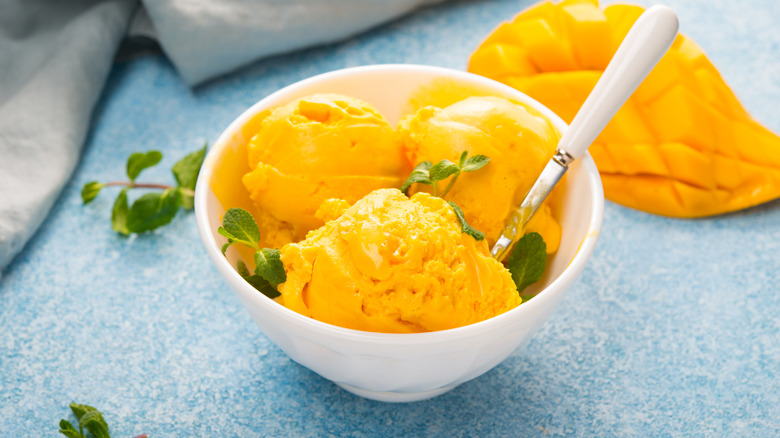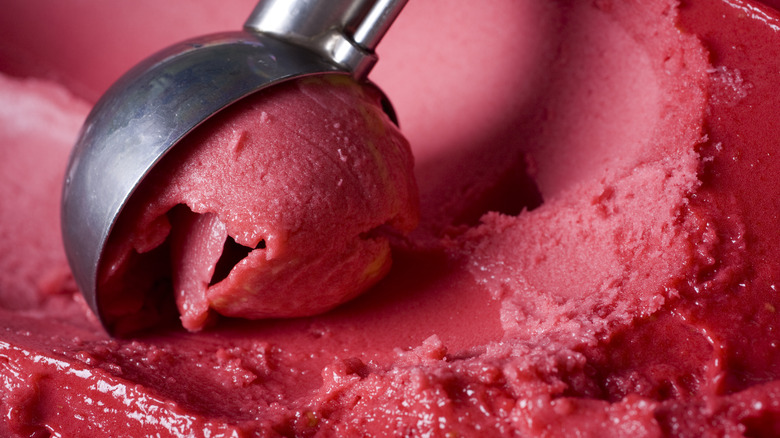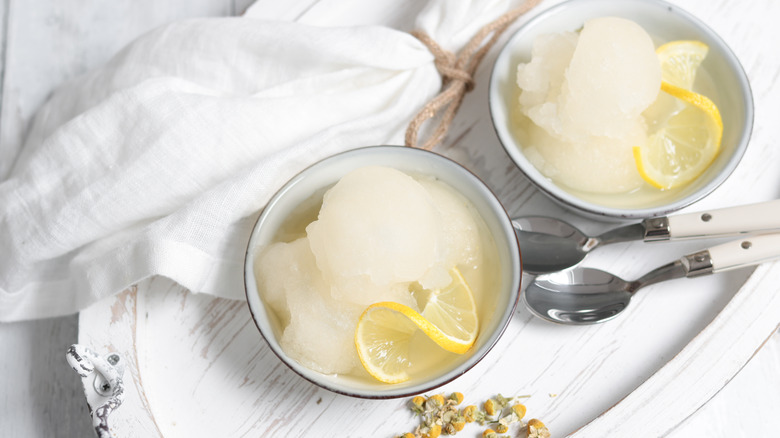The Creamy Difference Between Sorbet And Sherbet
When it comes to fruit-forward desserts in the frozen aisle, shoppers typically encounter two distinct options: sherbet and sorbet. Both scoopable desserts are teeming with juice from an assortment of fruits like berries, stone fruits, and melons, yet what sets them apart is the presence of dairy. Sherbet, akin to its relative ice cream, contains milk or cream, and sometimes egg whites or gelatin, to impart a creamy texture. In contrast, sorbet is essentially pure frozen fruit juice, resulting in a light, frosty consistency more reminiscent of shaved ice than creamy ice cream. In fact, your favorite canned fruit can double as a one-ingredient sorbet.
In the United States, the distinction between sherbet and sorbet is regulated by the government, with sherbet required to contain 1% to 2% butterfat, whereas sorbet contains none. This is quite modest when compared to ice creams, which have a butterfat content ranging from 10% to 20%, positioning sherbet and sorbet as comparatively lighter choices.
Sherbet is more difficult to define globally
While sorbet is usually easy to define, sherbet can be more elusive. Both desserts are always fruit-based — which sets them apart from ice cream — but the term "sherbet" means different things in different countries. For instance, in the Middle East, it typically describes a chilled soft drink primarily made with fruits and herbs, while in Britain, it denotes a type of sweet powder that can be eaten as candy, or put into a drink to make it fizzy. The dairy-infused sherbet familiar in the U.S. has murky origins, but a creamy pink pineapple sherbet flavor became notably popular in the 1950s.
Along with dairy, many sherbet recipes incorporate egg whites and unflavored gelatin, which lend a silky mouthfeel to the dessert. This results in a frozen dish that more closely mimics the texture of ice cream. Sorbets, meanwhile, remain dairy-free and retain a distinctly icy texture.
How to serve sorbet and sherbet
With this dairy difference in mind, should you treat sorbet differently from sherbet? For sherbet, the addition of cream makes it a more decadent option, with the smooth, dreamy texture we normally associate with ice creams. The flavors are also more straightforwardly sweet. Because of this, it probably works better as a stand-alone dessert rather than as a bright palate cleanser between meals. Serve it in a bowl all by itself, or in a perfectly caramelized waffle cone.
For sorbet, the answer mostly depends on your own personal preferences. Decidedly icier, the sorbet will be colder on the tongue (the fat from dairy normally softens the chill) and pack more of a sweet-tart punch. Sorbets are often paired with boozy liqueur, like this pisco sour sorbet. They can also include unexpected flavor additions like mint, tarragon, or other herbs. It has an overall more sophisticated feel and a lightness to it that can make it easy to eat before transitioning to a heavy dinner course. Still, if you like that brightness all its own, feel free to enjoy sorbet as the dessert finale. You won't be disappointed either way.



